Market
Lawyer Seeks Interpol Red Notice for LIBRA’s Hayden Davis

The LIBRA meme coin scandal, which sent shockwaves through Argentina’s political and financial spaces, has entered a new phase. Argentine lawyer Gregorio Dalbón has formally requested an international arrest warrant for Hayden Davis, the alleged key figure behind the token’s collapse.
Meanwhile, the Libra price remains steeply declining amid frothing FUD (fear, uncertainty, and doubt), with the broader bearish market outlook exacerbating the losses.
Argentine Lawyer Pursues Legal and Financial Fallout in Libra Scandal
Dalbón, who also represented former Argentine President Cristina Fernández de Kirchner in a corruption case, filed the petition on Tuesday. Local media Página12 reported that other legal experts in the case include lead prosecutor Eduardo Taiano and Judge María Servini.
The request seeks an Interpol Red Notice for Davis. It urges law enforcement worldwide to locate and provisionally arrest him pending extradition from the US. Dalbón’s petition argues that Davis poses a significant flight risk due to his financial resources and foreign residence.
“Given the magnitude of the scandal and the significant losses caused to investors, the procedural risk implied by Hayden Mark Davis remaining free is evident,” Argentina local media Perfil wrote, citing the petition.
Dalbón also contends that Davis played a “central role in creating and promoting LIBRA.” He says this reinforces allegations that the token’s launch and subsequent collapse were orchestrated for insider profit.
The push comes as this scandal deeply implicated President Javier Milei’s administration. This worsened after he publicly promoted the LIBRA token shortly before its catastrophic price crash. The case has sparked major controversy in Argentina, with authorities already moving to freeze approximately $100 million in crypto linked to the scheme earlier this month.
LIBRA Insiders Profited While Investors Lost Millions
Blockchain analysis firm Nansen recently reported that retail investors suffered staggering losses of $251 million. Meanwhile, wallets associated with Davis and another key figure, Kelsier, extracted significant profits before the token’s collapse.
Blockchain investigator Bubblemaps also uncovered evidence of market manipulation. It cited tactics such as “sniping” – using bots to buy tokens early and control liquidity.
Davis admitted to these tactics, claiming they were designed to prevent an immediate collapse and reinvest liquidity once President Milei resumed promoting the token. However, this strategy failed, leaving retail investors with heavy losses while insiders suffered substantial gains.
Further investigations linked the LIBRA meme coin team to other controversial crypto projects. Reports indicate connections between LIBRA insiders and MELANIA. The LIBRA team reportedly discussed launching a similar token with the Nigerian government, raising concerns about repeated exploitative crypto ventures across multiple countries.
The ripple effects of the scandal have also led to significant shake-ups in the crypto industry. Ben Chow, co-founder of the decentralized finance platform Meteora, recently resigned amid the controversy. This highlights the broader impact of the LIBRA debacle on the crypto ecosystem.
If Dalbón’s request for a Red Notice is approved, Interpol will distribute it to its 195 member countries. While a Red Notice does not mandate arrests, it signals to law enforcement agencies worldwide that Davis is wanted for extradition.
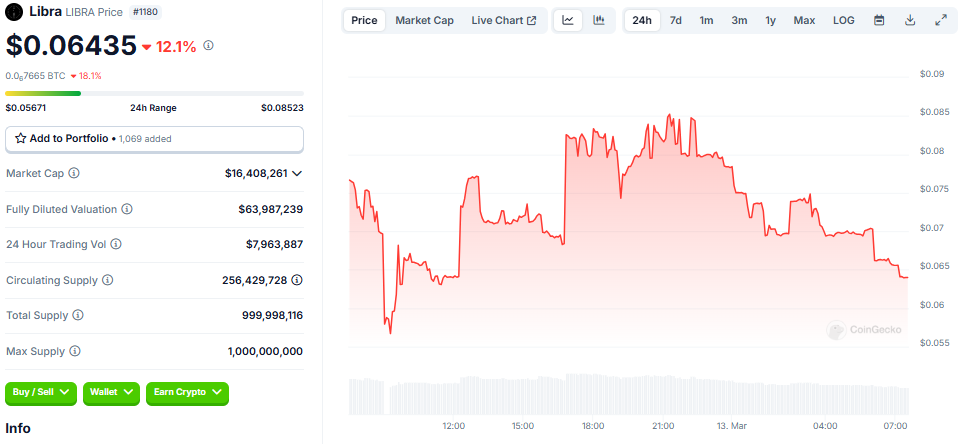
Data on CoinGecko shows that the LIBRA meme coin was trading for $0.06435 as of this writing, down over 12% in the past 24 hours.
Disclaimer
In adherence to the Trust Project guidelines, BeInCrypto is committed to unbiased, transparent reporting. This news article aims to provide accurate, timely information. However, readers are advised to verify facts independently and consult with a professional before making any decisions based on this content. Please note that our Terms and Conditions, Privacy Policy, and Disclaimers have been updated.
Market
How $31 Trillion in US Bonds Could Impact Crypto Markets in 2025

US Treasury plans to issue over $31 trillion in bonds this year—around 109% of GDP and 144% of M2. This would be the highest recorded level of bond issuance in history. How will it impact the crypto market?
Heavy supply may push yields higher, as Treasury financing needs outstrip demand. Higher yields increase the opportunity cost of holding non‑yielding assets like Bitcoin and Ethereum, potentially drawing capital away from crypto.
US Bonds Might Add to the Crypto Market’s Volatility
The whole narrative potentially boils down to foreign demand for US bonds. Overseas investors hold roughly one‑third of US debt.
Any reduction in appetite—whether due to tariffs or portfolio rebalances—could force the Treasury to offer even steeper yields. Rising yields tend to tighten global liquidity, making risk assets like cryptocurrencies less attractive.
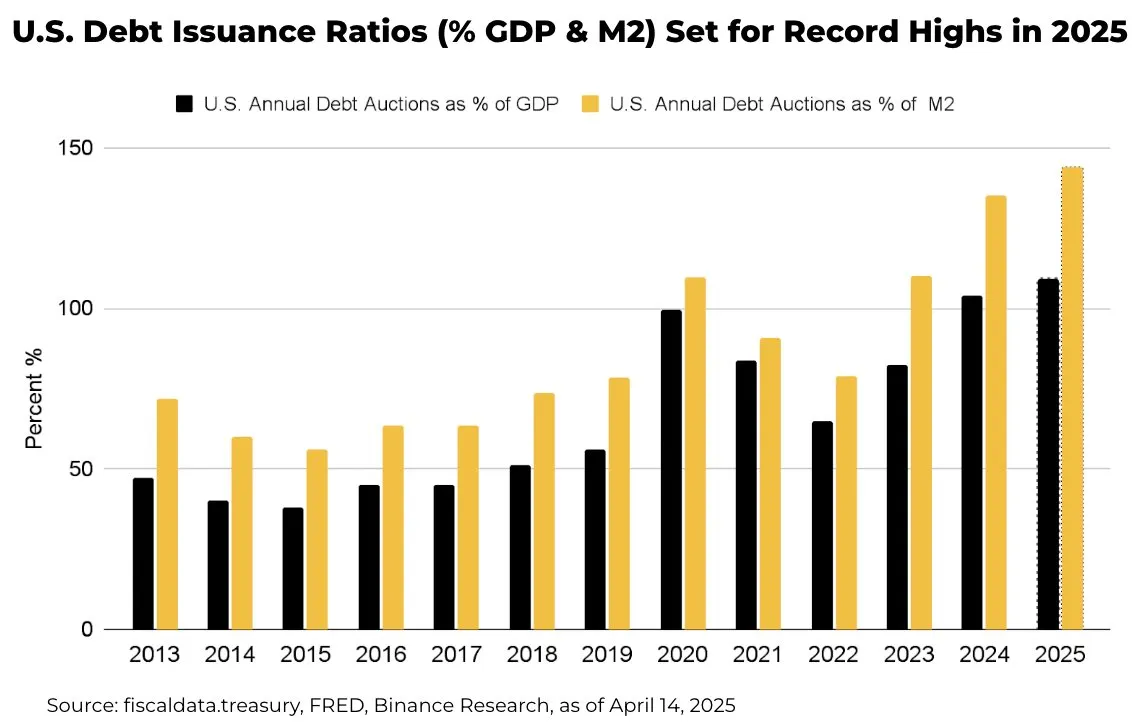
When yields climb, equities and crypto can face selling pressure. For example, during the 2022 bond sell‑off, Bitcoin fell more than 50% alongside Treasury yields spiking. A repeat scenario could test crypto’s appeal.
Meanwhile, the US dollar’s strength could compound headwinds. As yields rise, the dollar typically gains. A stronger dollar makes Bitcoin’s USD‑denominated price more expensive for overseas buyers, dampening demand.
Yet crypto offers unique attributes. In periods of extreme monetary expansion, such as post‑pandemic, investors turned to Bitcoin as an inflation hedge.
Even if higher yields curb speculative flows, crypto’s finite supply and decentralized nature may sustain a baseline of buyer interest.
Technically, Bitcoin’s correlation to yields may weaken if Treasury issuance triggers broader macro volatility. When bond markets are hit by trade or fiscal policy shocks, traders may turn to digital assets to diversify since they don’t move in step.
However, that thesis hinges on continued institutional adoption and favorable regulation.
Crypto’s liquidity profile also matters. Large bond sales often drain bank reserves—tightening funding markets.
In theory, tighter liquidity could boost demand for DeFi protocols offering higher yields than traditional money markets.
Overall, record US debt supply points to higher yields and a stronger dollar—volatility for crypto as a risk asset.
Yet crypto’s inflation‑hedge narrative and evolving technical role in diversified portfolios could temper volatility. Market participants should watch foreign demand trends and liquidity conditions as key indicators for crypto’s next moves.
Disclaimer
In adherence to the Trust Project guidelines, BeInCrypto is committed to unbiased, transparent reporting. This news article aims to provide accurate, timely information. However, readers are advised to verify facts independently and consult with a professional before making any decisions based on this content. Please note that our Terms and Conditions, Privacy Policy, and Disclaimers have been updated.
Market
Are Ethereum Whales Threatening ETH Price Stability?

Ethereum (ETH) continues to struggle below the $2,000 mark, a level it hasn’t reclaimed since March 28, as bearish momentum lingers across both technical and on-chain indicators. Despite attempts to stabilize, recent data reveals rising concentration of ETH among whale wallets, alongside persistent weakness in trend indicators like EMA lines.
At the same time, retail and mid-sized holders are gradually losing share, further skewing ownership toward large players. This combination of declining retail participation and heavy whale dominance may leave ETH increasingly vulnerable to sharp corrections if sentiment turns.
ETH Whale Holdings Hit 9-Year High, Raising Centralization Concerns
The amount of ETH held by whale addresses—wallets controlling more than 1% of the total circulating supply—has reached its highest level since 2015, sitting at 46%.
This marks a significant shift in Ethereum’s ownership data, as whales surpassed the holdings of retail investors back on March 10 and have continued to grow their share since. In comparison, investor-level addresses, which hold between 0.1% and 1% of supply, and retail wallets, which hold less than 0.1%, have both seen declines in their share of ETH.
The jump from 43% to 46% in just a few months reflects a sharp accumulation trend among the largest holders, suggesting a growing concentration of ETH in fewer hands.

Whales typically represent institutional investors, funds, or early adopters, and their behavior can significantly impact price due to the volume they control. Investor-level addresses often reflect high-net-worth individuals or smaller institutions, while retail addresses include everyday traders and holders.
While some might see the rise in whale holdings as a vote of confidence, it also increases the risk of sudden volatility if large holders begin offloading.
With retail and investor participation shrinking, the market may become more fragile and vulnerable to sharp, unexpected price movements driven by a few dominant players.
Whales Holding 1,000 to 100,000 ETH Now Control $59 Billion
Analyzing the ETH Holdings Distribution Matrix reveals concerning signs of deepening concentration.
When excluding addresses with over 100,000 ETH—typically linked to centralized exchanges—whale addresses holding between 1,000 and 100,000 ETH now control roughly $59 billion in ETH, representing around 25.5% of the circulating supply.
This group has steadily accumulated more of the network’s supply, reinforcing a power shift toward large entities operating outside of exchanges but still commanding immense influence over the market. Recently, Galaxy Digital moved $100 million in Ethereum, raising questions about whether it was a strategic shift or a sell-off signal.
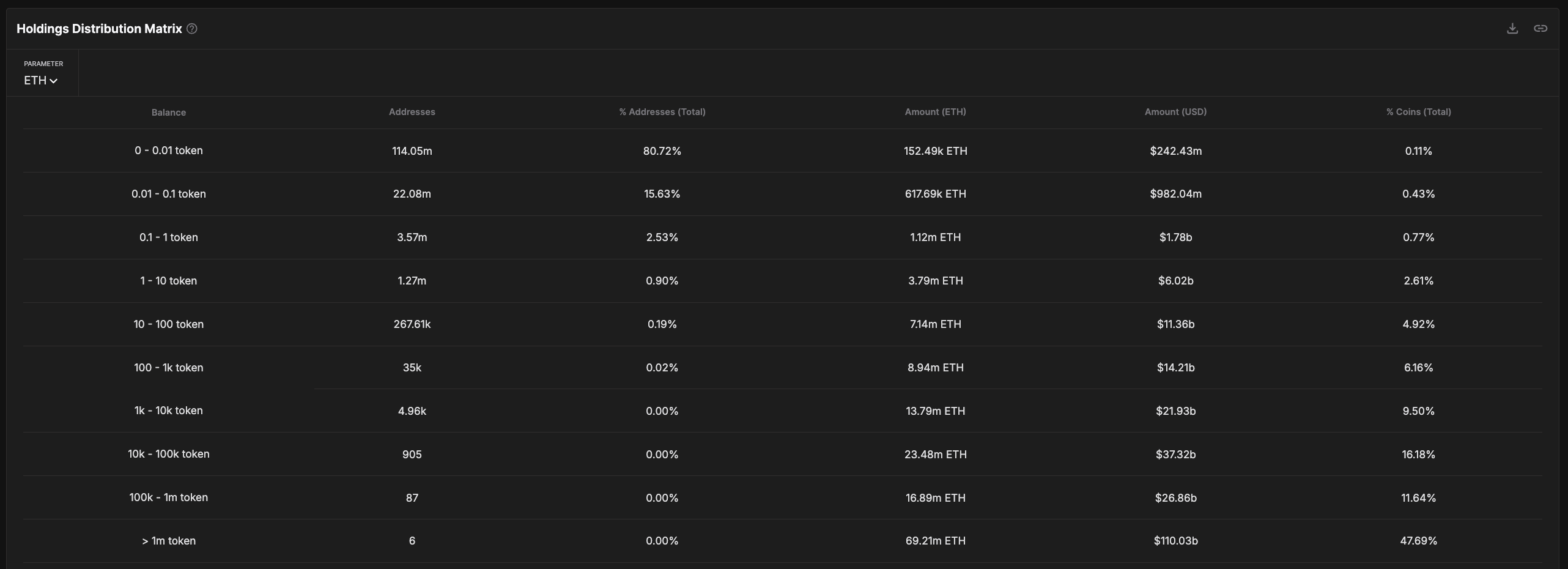
While some might interpret this trend as strategic positioning by confident holders, it also exposes Ethereum to significant downside risk.
With over a quarter of supply concentrated in the hands of these whales, any coordinated or panic-driven selling could trigger sharp price drops, especially in an environment with weakening retail participation.
Rather than a sign of long-term stability, this level of concentration may make the ETH market increasingly fragile and prone to volatility if these holders start to rotate their capital to other assets.
Bearish EMA Structure Keeps ETH Under Pressure
Ethereum’s EMA lines continue to flash bearish signals, with short-term averages still positioned below the long-term ones—indicating downward momentum remains in play.
If a new correction happens, Ethereum could first test support at $1,535. A breakdown below that level opens the door to deeper declines toward $1,412 or even $1,385.
Should these supports also fail to hold, Ethereum would edge dangerously close to the $1,000 mark, a level some analysts have flagged as a potential downside target in the event of an extended market correction.
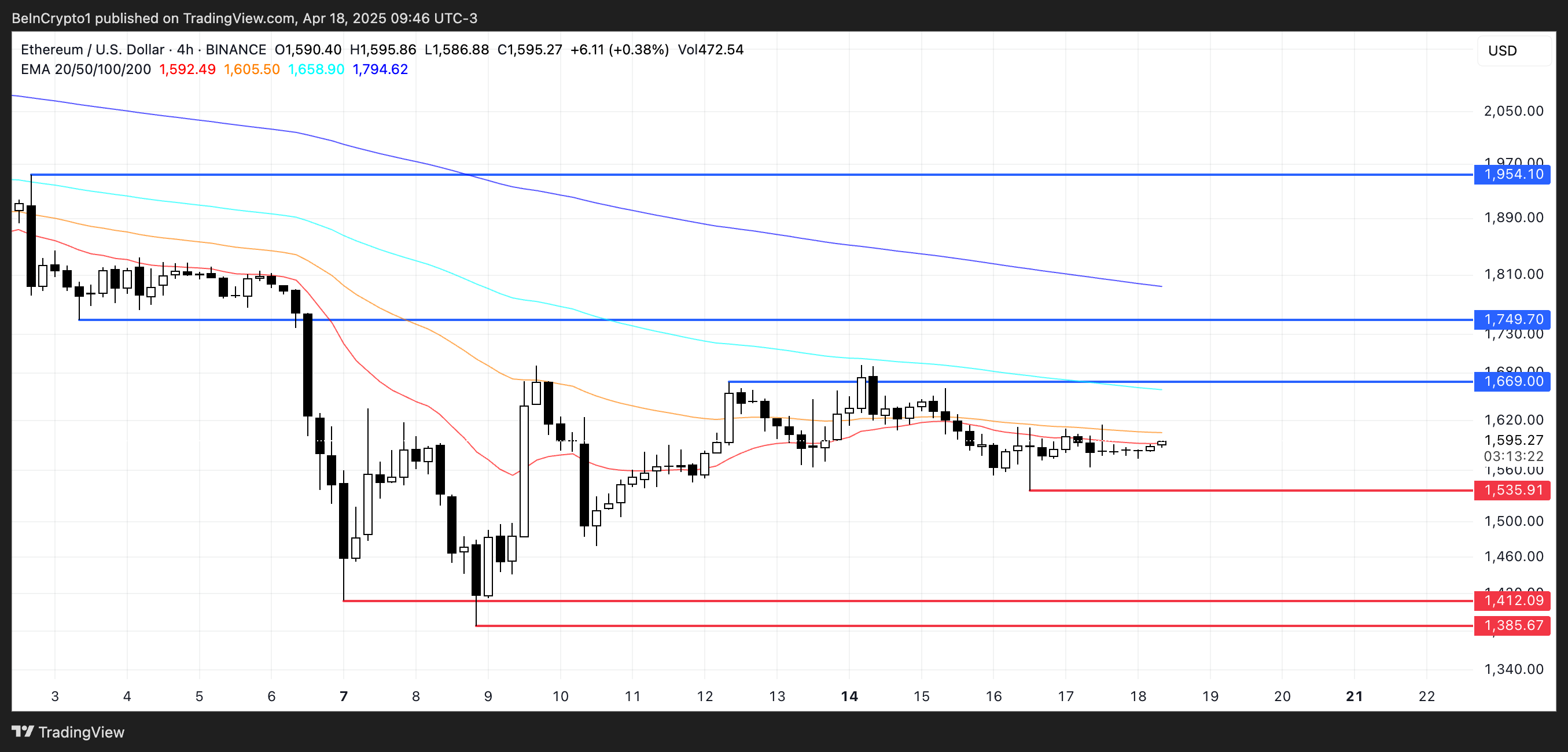
Still, a bullish reversal is not entirely out of the question. If buying pressure returns and Ethereum reclaims short-term momentum, it could test the resistance level at $1,669.
A breakout above that would be a significant technical signal, potentially pushing Ethereum price toward $1,749 and even $1,954.
However, with EMAs still tilted to the downside, the burden remains on bulls to prove that momentum has shifted decisively in their favor.
Disclaimer
In line with the Trust Project guidelines, this price analysis article is for informational purposes only and should not be considered financial or investment advice. BeInCrypto is committed to accurate, unbiased reporting, but market conditions are subject to change without notice. Always conduct your own research and consult with a professional before making any financial decisions. Please note that our Terms and Conditions, Privacy Policy, and Disclaimers have been updated.
Market
CZ’s Plan to Streamline BNB Staking Could Boost DeFi

On Friday, Changpeng Zhao (CZ) sparked fresh momentum toward simplifying the BNB staking ecosystem.
The Binance founder proposed the unification of multiple liquid staking tokens into a single, streamlined structure.
CZ’s Bold Plan to Unify BNB’s Staking Maze
Changpeng Zhao’s comments come amid rising concerns over the fragmentation of BNB staking products. Their impact on user adoption and capital efficiency within the decentralized finance (DeFi) space has also been questioned.
“There are so many different versions of BNB rewards. asBNB, slisBNB, clisBNB… combine them?” CZ wrote on X (Twitter).
These tokens, each tied to a different platform or crypto staking strategy, represent staked BNB assets while allowing users to remain liquid.
However, the proliferation of variant tokens like asBNB, slisBNB, and clisBNB has created operational barriers for users, particularly newcomers. Each derivative often carries reward structures, lock-up conditions, and platform-specific limitations, making it harder to maneuver the ecosystem.
This highlights the growing problem in BNB’s liquid staking ecosystem. However, as more derivatives emerge, confusion has mounted. The call for consolidation follows recent activity in the BNB DeFi ecosystem. This week, Aster DEX (decentralized exchange) announced “back-to-back rewards” for asBNB holders.
While this added to the mix of incentives, it also highlighted the complexity of managing multiple tokens.
“INIT rewards are loading now and will be available for holders with previous rewards soon,” Aster posted.
The post demonstrates how derivative-specific reward systems may confuse users who are unfamiliar with each staking product’s nuances.
CZ shared a follow-up post, urging users to support projects in the ecosystem. The call to action reflects his commitment to nurturing BNB’s DeFi growth, albeit with a more coherent strategy.
As Binance aims to maintain its leadership in Web3 usability, Zhao’s suggestion to unify these staking derivatives could be a pivotal move to streamline BNB’s functionality across DeFi platforms.
BNB remains one of the most utilized assets in the DeFi ecosystem. The network underpins a wide array of liquidity pools, staking protocols, and yield-generating strategies.
CZ’s unification proposal aligns with a broader trend across DeFi to improve composability and standardization. Industry leaders increasingly recognize that overly complex or siloed token designs can deter participation and limit interoperability.
A standardized BNB staking token could help reduce fragmentation and boost liquidity. It could also encourage deeper integration across platforms using BNB Chain infrastructure.
While Binance has not yet issued an official roadmap for staking token consolidation, CZ’s comments may hint at a coming initiative to build a unified liquid staking standard.
Such a move could further solidify BNB’s position as a core DeFi asset, simplify staking for everyday users, and drive broader adoption of Binance’s on-chain ecosystem.
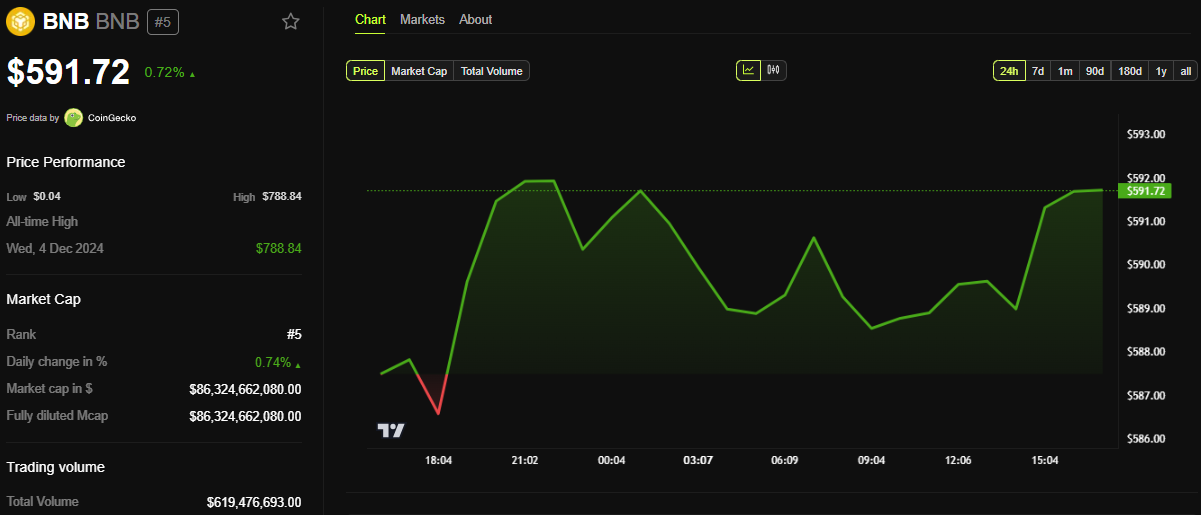
BeInCrypto data shows BNB was trading for $591.72 as of this writing, up by a modest 0.72% in the last 24 hours.
Disclaimer
In adherence to the Trust Project guidelines, BeInCrypto is committed to unbiased, transparent reporting. This news article aims to provide accurate, timely information. However, readers are advised to verify facts independently and consult with a professional before making any decisions based on this content. Please note that our Terms and Conditions, Privacy Policy, and Disclaimers have been updated.
-

 Market23 hours ago
Market23 hours agoOver $700 Million In XRP Moved In April, What Are Crypto Whales Up To?
-

 Altcoin23 hours ago
Altcoin23 hours agoCZ Honors Nearly $1 Billion Token Burn Promise
-

 Market22 hours ago
Market22 hours agoCrypto Casino Founder Charged With Fraud in New York
-

 Ethereum21 hours ago
Ethereum21 hours agoEthereum Whales Offload 143,000 ETH In One Week – More Selling Ahead?
-

 Altcoin16 hours ago
Altcoin16 hours agoTron Founder Justin Sun Reveals Plan To HODL Ethereum Despite Price Drop
-

 Market13 hours ago
Market13 hours agoEthereum Price Fights for Momentum—Traders Watch Key Resistance
-

 Market19 hours ago
Market19 hours agoCrypto Ignores ECB Rate Cuts, Highlighting EU’s Fading Influence
-
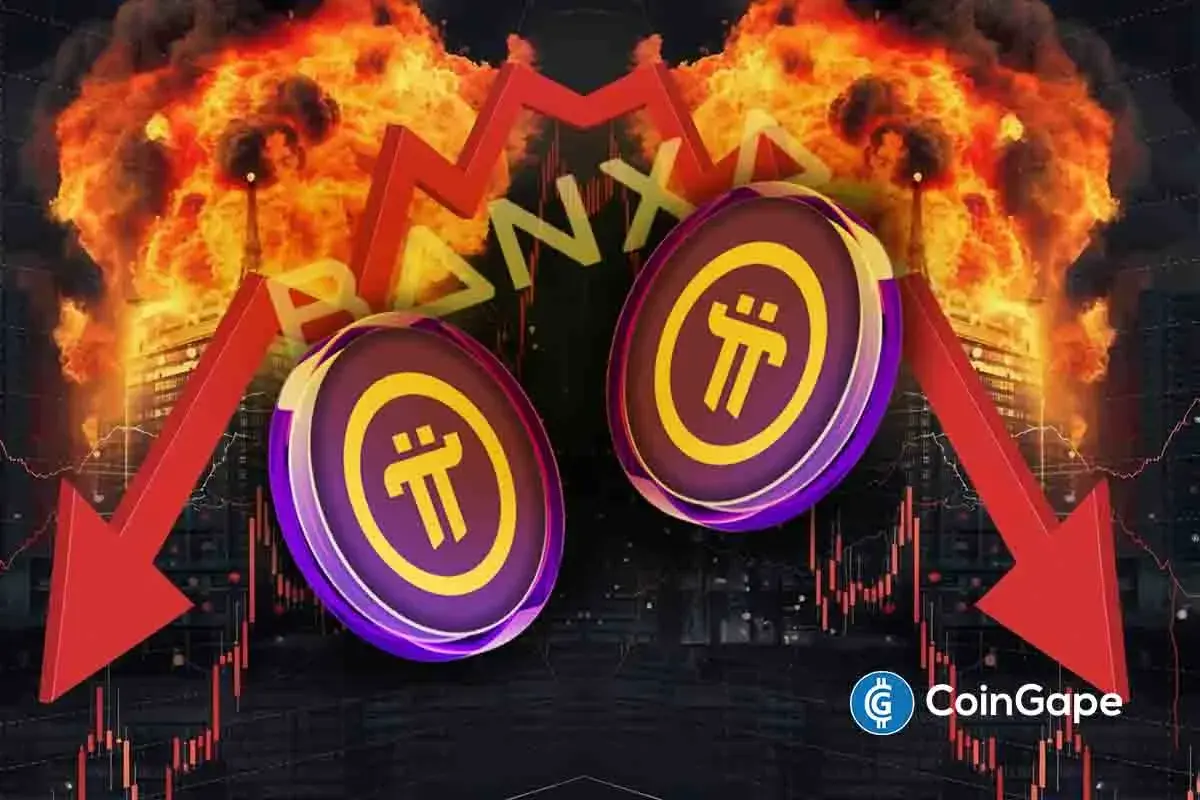
 Altcoin13 hours ago
Altcoin13 hours agoExpert Predicts Pi Network Price Volatility After Shady Activity On Banxa




















